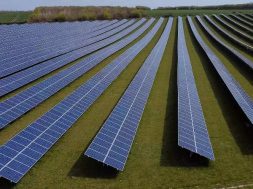
Chinese solar panels cloud prospects of $2 billion investment in domestic units
NEW DELHI: Indian solar module makers are struggling to stay in business as the price differential with imports has widened to 10-12%, prompting developers to opt for overseas supplies and stunting government’s ‘Make in India’ campaign.
Nearly all major domestic players such as Indosolar, Tata Power Solar, Adani Group, Jupiter Solar and state-run Bhel are struggling to remain viable in the face of undercutting by cheaper supplies from modules manufactured by Chinese-owned companies located in the mainland and outside.
“The government wants the world to ‘Make in India’. We want to make in India and are confident of being competitive in a level field. But how do you compete against the Chinese who have created overcapacity with big support from their government and prefer to ‘Dump in India’ instead of setting up shop here,” one senior industry executive told TOI requesting anonymity.
The situation is similar to what happened a decade back when the government set out on an ambitious plan to expand thermal generation capacity.
Developers opted for cheaper equipment from China to offer low tariffs, which nearly pushed domestic manufacturers to the brink till the government levelled the field with quality and other norms.
Ironically, the government is faced with the same question as it targets to set up 100 GW (giga watt) solar power capacity by 2022. India is expected to place orders for about 80,000 MW (mega watt) of solar power installations worth nearly Rs 2.44 lakh crore at current prices. India’s utility-scale solar power capacity stands at 16 GW, while 11.5 GW is in the pipeline and 5.6 GW is being readied for bidding.
Cheaper imports last year helped pull down solar power tariff to Rs 2.44 per unit, or lower than coal-fired electricity. But a rush of imports has made domestic manufacturers fear for their $2 billion investment.
“Domestic manufacturers have around 3,000-4,000 MW of projects set up or tendered. Developers prefer cheap equipment as their interest spans five-seven years within which they seek to recover costs. But projects have a 25-year span. So you are compromising on quality with cheap imports at the cost of the project’s future,” Karunesh Kumar Chaturvedi of Vikram Solar told TOI.
Industry estimates say a significant portion of 3,164 MW of domestic solar cell-making capacity is either defunct or operating at losses and every 1,000 MW lost manufacturing capacity costs 3,000 jobs.
“Many domestic manufacturers are somehow surviving because they also have solar project construction contracts… we are not asking for same duty on imported cells due to mismatch in domestic capacity for these items. But a differential import duty on them will level the field,” Chaturvedi said.
Continued pressure on domestic solar units are likely to increase bad loans. Already Moserbaer Solar is facing insolvency proceedings, with total debt of Rs 1,000 crore. Websol Energy faced a similar situation in 2013 in the form of liquidation after burdened with debt of Rs 350 crore in working capital and long-term loans.
















